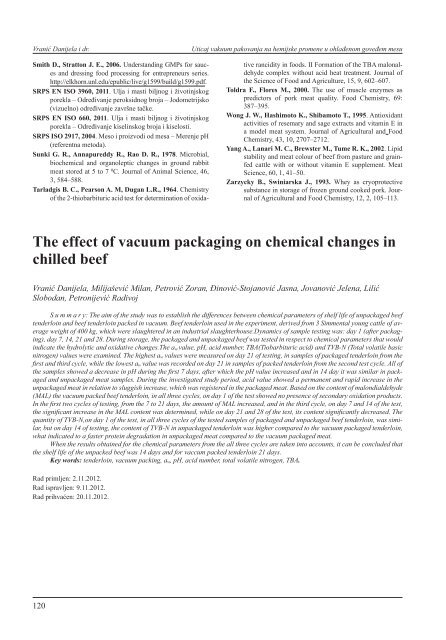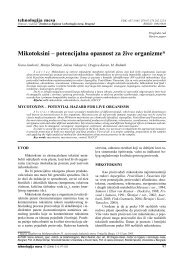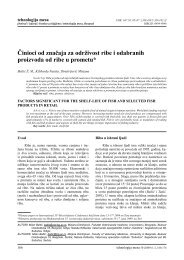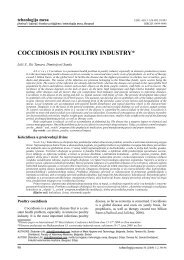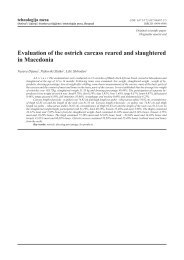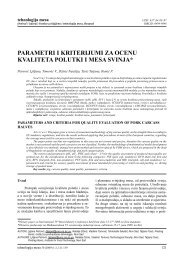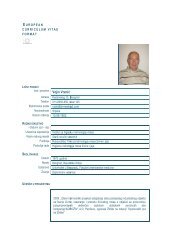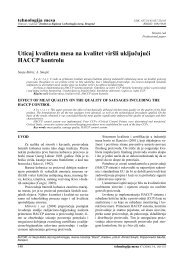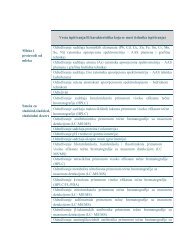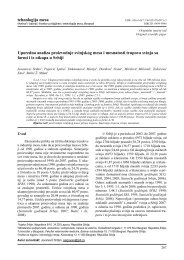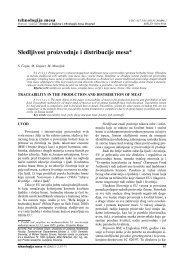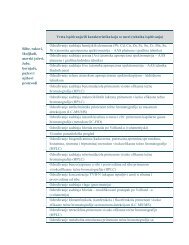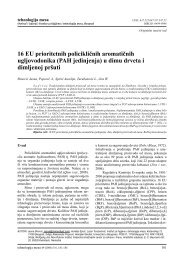Najnoviji broj Äasopisa - inmesbgd.com
Najnoviji broj Äasopisa - inmesbgd.com
Najnoviji broj Äasopisa - inmesbgd.com
You also want an ePaper? Increase the reach of your titles
YUMPU automatically turns print PDFs into web optimized ePapers that Google loves.
Vranić Danijela i dr.<br />
Uticaj vakuum pakovanja na hemijske promene u ohlađenom goveđem mesu<br />
Smith D., Stratton J. E., 2006. Understanding GMPs for sauces<br />
and dressing food processing for entrepreneurs series.<br />
http://elkhorn.unl.edu/epublic/live/g1599/build/g1599.pdf.<br />
SRPS EN ISO 3960, 2011. Ulja i masti biljnog i životinjskog<br />
porekla – Određivanje peroksidnog <strong>broj</strong>a – Jodometrijsko<br />
(vizuelno) određivanje završne tačke.<br />
SRPS EN ISO 660, 2011. Ulja i masti biljnog i životinjskog<br />
porekla – Određivanje kiselinskog <strong>broj</strong>a i kiselosti.<br />
SRPS ISO 2917, 2004. Meso i proizvodi od mesa – Merenje pH<br />
(referentna metoda).<br />
Sunki G. R., Annapureddy R., Rao D. R., 1978. Microbial,<br />
biochemical and organoleptic changes in ground rabbit<br />
meat stored at 5 to 7 0 C. Journal of Animal Science, 46,<br />
3, 584–588.<br />
Tarladgis B. C., Pearson A. M, Dugan L.R., 1964. Chemistry<br />
of the 2-thiobarbituric acid test for determination of oxidative<br />
rancidity in foods. II Formation of the TBA malonaldehyde<br />
<strong>com</strong>plex without acid heat treatment. Journal of<br />
the Science of Food and Agriculture, 15, 9, 602–607.<br />
Toldra F., Flores M., 2000. The use of muscle enzymes as<br />
predictors of pork meat quality. Food Chemistry, 69:<br />
387–395.<br />
Wong J. W., Hashimoto K., Shibamoto T., 1995. Antioxidant<br />
activities of resemary and sage extracts and vitamin E in<br />
a model meat system. Journal of Agricultural and Food<br />
Chemistry, 43, 10, 2707–2712.<br />
Yang A., Lanari M. C., Brewster M., Tume R. K., 2002. Lipid<br />
stability and meat colour of beef from pasture and grainfed<br />
cattle with or without vitamin E supplement. Meat<br />
Science, 60, 1, 41–50.<br />
Zarzycky B., Swiniarska J., 1993. Whey as cryoprotective<br />
substance in storage of frozen ground cooked pork. Journal<br />
of Agricultural and Food Chemistry, 12, 2, 105–113.<br />
The effect of vacuum packaging on chemical changes in<br />
chilled beef<br />
Vranić Danijela, Milijašević Milan, Petrović Zoran, Đinović-Stojanović Jasna, Jovanović Jelena, Lilić<br />
Slobodan, Petronijević Radivoj<br />
S u m m a r y: The aim of the study was to establish the differences between chemical parameters of shelf life of unpackaged beef<br />
tenderloin and beef tenderloin packed in vacuum. Beef tenderloin used in the experiment, derived from 3 Simmental young cattle of average<br />
weight of 400 kg, which were slaughtered in an industrial slaughterhouse.Dynamics of sample testing was: day 1 (after packaging),<br />
day 7, 14, 21 and 28. During storage, the packaged and unpackaged beef was tested in respect to chemical parameters that would<br />
indicate the hydrolytic and oxidative changes.The a w value, pH, acid number, TBA(Tiobarbituric acid) and TVB-N (Total volatile basic<br />
nitrogen) values were examined. The highest a w values were measured on day 21 of testing, in samples of packaged tenderloin from the<br />
fi rst and third cycle, while the lowest a w value was recorded on day 21 in samples of packed tenderloin from the second test cycle. All of<br />
the samples showed a decrease in pH during the fi rst 7 days, after which the pH value increased and in 14 day it was similar in packaged<br />
and unpackaged meat samples. During the investigated study period, acid value showed a permanent and rapid increase in the<br />
unpackaged meat in relation to sluggish increase, which was registered in the packaged meat. Based on the content of malondialdehyde<br />
(MAL) the vacuum packed beef tenderloin, in all three cycles, on day 1 of the test showed no presence of secondary oxidation products.<br />
In the fi rst two cycles of testing, from the 7 to 21 days, the amount of MAL increased, and in the third cycle, on day 7 and 14 of the test,<br />
the significant increase in the MAL content was determined, while on day 21 and 28 of the test, its content signifi cantly decreased. The<br />
quantity of TVB-N,on day 1 of the test, in all three cycles of the tested samples of packaged and unpackaged beef tenderloin, was similar,<br />
but on day 14 of testing, the content of TVB-N in unpackaged tenderloin was higher <strong>com</strong>pared to the vacuum packaged tenderloin,<br />
what indicated to a faster protein degradation in unpackaged meat <strong>com</strong>pared to the vacuum packaged meat.<br />
When the results obtained for the chemical parameters from the all three cycles are taken into accounts, it can be concluded that<br />
the shelf life of the unpacked beef was 14 days and for vaccum packed tenderloin 21 days.<br />
Key words: tenderloin, vacuum packing, a w, pH, acid number, total volatile nitrogen, TBA.<br />
Rad primljen: 2.11.2012.<br />
Rad ispravljen: 9.11.2012.<br />
Rad prihvaćen: 20.11.2012.<br />
120


